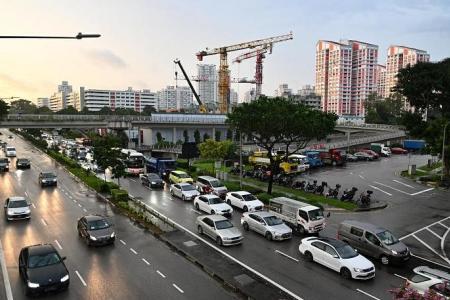COE prices could dip in latter half of 2023
Certificate of entitlement (COE) premiums went on a relentless upward march for much of 2022, with all-time highs set in four out of five categories – larger and more powerful cars, commercial vehicles, motorcycles and the Open category.
Premiums for the remaining COE category – for cars with less power – ended $1,511, or 1.6 per cent, shy of the $92,100 record set in January 2013 at the second-last tender exercise of 2022.
Consumers may get a slight reprieve in the latter half of 2023, however, as vehicle population data suggests that premiums may come down slightly as the supply of COEs starts to increase.
Mr Ron Lim, head of sales at Nissan agent Tan Chong Motor, forecasts that the supply of COEs could improve from August, but added that it could happen as late as November 2023 onwards.
Mr Nicholas Wong, general manager of Kah Motor, which distributes Honda cars, hopes that more COEs will be available from June onwards as the number of deregistrations increases.
He estimates the increase in the COE category for larger and more powerful cars and EVs to be “less than 3 per cent”, while the supply of COEs for smaller and less powerful cars may grow by as much as 10 per cent.
But before the COE supply improves, 2023 is going to start where 2022 ended – where the supply of COEs is low and premiums are high.
The high prices of 2022 have been driven by the low supply of COEs, which is primarily determined by the number of vehicles being taken off the road. Transport Minister S. Iswaran said in November that demand for vehicles has been strong.
Besides the restrictive supply, other factors also contributed in chasing up premiums.
The two car COE categories are differentiated by engine size and power output. In May, a criterion specific to electric vehicles (EVs) was introduced as part of Singapore’s push for EV adoption.
EVs with up to 110 kilowatts of power were moved to the typically cheaper Category A, where the power threshold for non-EVs was 130bhp or 97 kW.
Some motor dealers said the move effectively pushed up the price of Category A COEs, as EVs receive $25,000 in rebate through the Enhanced Vehicular Emissions Scheme. This gives buyers more bidding muscle over non-EVs.
Comparing COE premiums from the first and last tender exercises in 2022, the price gap between the traditionally cheaper car category and the more expensive Category B, which is meant for larger and more powerful cars and EVs, has narrowed from 34 per cent to 22.7 per cent.
Category A prices managed to close in, even as Category B prices have also been climbing in 2022, hitting a record high of $115,388 at the first tender exercise in November 2022. Although Open category COEs can be used to register any type of vehicle other than motorcycles, they usually end up being used to register Category B cars. The price for this type of COE hit a new high at the same tender to close at $116,577.
That particular tender exercise was the first under the new quota period from November 2022 to January 2023. The number of COEs for Category B cars available was 12.9 per cent less than in the previous three months, while that for Open category vehicles was 11 per cent smaller.
Category B COEs apply to a large variety of models, spanning many petrol-hybrid models, larger family cars, as well as the top-rung luxury limousines and sports cars. This increases the demand for Category B COEs, and buyers of the more expensive models also tend to be able to afford higher COE prices.
Motorcycle COE prices broke records repeatedly in 2022. The peak of $13,189 set in November was more than 7.8 times higher than the $1,701 peak of 2010, when the supply of such COEs was at its lowest.
This is despite measures introduced in March on the back of surging motorcycle COE premiums. Back then, the authorities halved the validity period of secured COEs to three months, so the unused COEs can be returned to the pool for bidding sooner. The bid deposit was also raised from $200 to $800 to make it more expensive for bidders to “waste” a secured COE.
However, motorcycle COE premiums started rising again in June after falling in April and May. Motorcycle dealers said the rise of food delivery services fuelled the demand for such COEs.
Meanwhile, commercial vehicle COE prices nearly doubled in 2022. The COE price started the year at $42,200 and hit $81,802 in the second tender exercise in November, breaking the record of $76,310 set in October 2013.
At 2,092 pieces, the supply of such COEs in 2022 was less than half of the 4,537 COEs available in 2021.
This marked reduction in supply comes from the widespread adoption of the Early Turnover Scheme. The COEs for commercial vehicles that are retired under this scheme are not released to the pool for bidding. Instead, owners pay a discounted COE price to register a new truck or bus with cleaner emissions without having to bid for a new COE.
Between January and November, 6,851 new commercial vehicles were registered through this route, 3.6 times more than the 1,918 vehicles registered using new commercial vehicle COEs.
The demand for commercial vehicles is said to be driven by the Commercial Vehicle Emissions Scheme, which incentivises businesses to choose cleaner – mainly electric – light goods vehicles. Such vehicles are given up to $30,000 in cash incentives over more pollutive vans and minibuses.
The general resumption of economic activity, which leads to greater demand for trucks and buses, is another often-cited factor driving up commercial vehicle premiums.
For 2023, the number-crunching suggests that COE supply will remain low overall and that premiums will stay high for at least the first half of 2023.
According to available data on vehicle population age, there were 25,636 vehicles that are a year away from their 10th anniversary, and another 29,349 vehicles will reach their 15th year as at January 2022.
While some vehicles have their COEs revalidated when they turn 10, those that do not – along with those turning 15 whose COEs were revalidated for only five years – will have to be deregistered. These will form the basis for the number of COEs available in 2023.
The total of 54,985 vehicles as at January 2022 was lower than the 57,709 vehicles for the same period in 2021, which suggests that there will be a smaller supply of COEs in the beginning of 2023.
The pool of vehicles that may be deregistered grows as the year progresses. As at November 2022, there were 66,464 vehicles that would be turning 10 or 15 years old in the next 12 months, potentially boosting the supply of COEs available for bidding in the months that follow.
On the demand front, January registrations could include orders that dealers have held back from before to start the year strong. The return of the Singapore Motorshow after a break of two years may just drive up COE prices even more.
However, Tan Chong Motor’s Mr Lim said changes in the broader economy may upend the predictions based on the data.
“We are also cautious of the overall economic sentiment. In the event of any recession setting in, COE premiums might soften earlier than expected,” he added.
Get The New Paper on your phone with the free TNP app. Download from the Apple App Store or Google Play Store now


